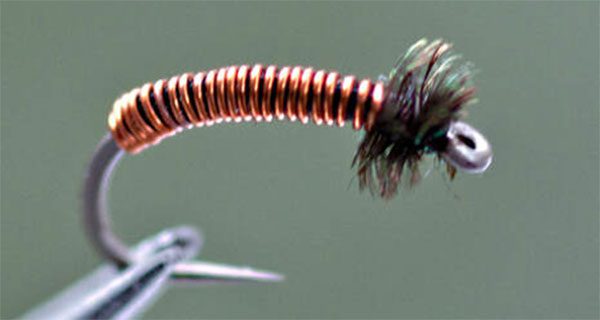My first encounter with the “copper fly” was on a trip to the Pennsylvania Spring Creeks in the Carlie area. In the absence of a hatch, Mike Bullock handed me a “copper fly” to tie on as a dropper. Mike’s copper fly, or what is better known as a Brassie, imitates midge larva and pupa, caddis larva and pupa, and many other small nymphs. The Brassie is a fine example of how little it takes to entice some trout– even highly selective trout in a spring creek or tailrace.
The original “copper fly” was tied using wire extracted from an electronic power transformer for the abdomen and a piece of heat shrink-wrap tape for the thorax. The Brassie fly pattern is named based on this original fine copper alloy transformer wire, which was a brass color. In the 1960s, Ken Chandler and Tug Davenport invented this early creation for use on the South Platte River near Denver, Colorado. My guess is that they were either electronics professionals or hobbyists with the give-away being the shrink-wrap tape. The shrink-wrap tape certainly made a highly imitative, durable fly pattern and they possibly intended the fly pattern to be an English like “buzzer” without the varnished coating. At some point though, peacock herl became the replacement material for the thorax as an even more attractive material for trout. The peacock herl thorax is irresistible to trout.
Using wire gives the appearance of segmentation. The most typical Brassie sizes tied are size 14 to size 20. Actual caddis larva and pupa range in length from size 10 to size 16. Larger gauges of wire from 12-gauge to 20-gauge are needed to match these hook sizes. Actual midges range in length from size 18 to size 28. Small gauges of wire from 20-gauge to 32-gauge are needed to match these hook sizes. A simple and highly effective fly pattern, such as the Brassie, allows the fly tyer to quickly and easily refill the fly box for the next fly fishing trip. The hook and wire alone provide weight for the Brassie fly pattern to sink toward the bottom. The least bit of current provides for a water column presentation much like a real larva rising to the surface as it transforms into a midge or caddis pupa. It may be used on a variety of streams especially during the fringe months in the spring and fall. It can imitate a Chironomid or midge pupae that lives underwater and levitates in the mid-water column. It catches fish under an indicator or retrieves behind sinking or floating line. It is deadly fished behind a floating line and a 9-foot to 12-foot fluorocarbon leader in a series of six short one-inch strips, followed by a long pause allowing it to fall again then repeat, imitating the natural rise of an emerging midge. The Brassie is a great addition behind any streamer when searching or trolling slowly. In the larger sizes it is a great caddis larva imitation in the western rivers.
Do not underestimate this fly, the Brassie is one of the best small fly patterns ever created. It fishes year-round almost everywhere because of its density. Fly fishing with a single Brassie generally requires an indicator, indicator fly, leading fly, a tandem presentation and 5X tippet. Although trout have keen eyesight, the visibility of a very small fly pattern may be enhanced by the co-existence of another fly. An indicator or indicator fly will be highly visible and theoretically draws the attention of the trout. With such attention, the tiny Brassie is there for a “bait and switch” presentation.
A similar, yet amazing technique, is to tie on a leading wet fly, soft hackle, or streamer with the Brassie as a trailer. First fly gets attention, Brassie gets the strike. The same is true for a tandem presentation using two Brassies. However, with a tandem presentation in the water column, either fly may receive the strike. Keep in mind that on tailraces and spring creeks, a 5X tippet is too big, so plan to 6X, 6.5X or 7X tippets with the Brassie.
Hook: Tiemco 2488
Size: 16, 18, 20, 22, 24
Thread: Danville 70 in black
Body: UTC Wire sized for hook in Copper
Thorax: Peacock Herl
Directions: Detailed tying steps may be found at www.rockyrivertu.org/dry-fly-patterns
